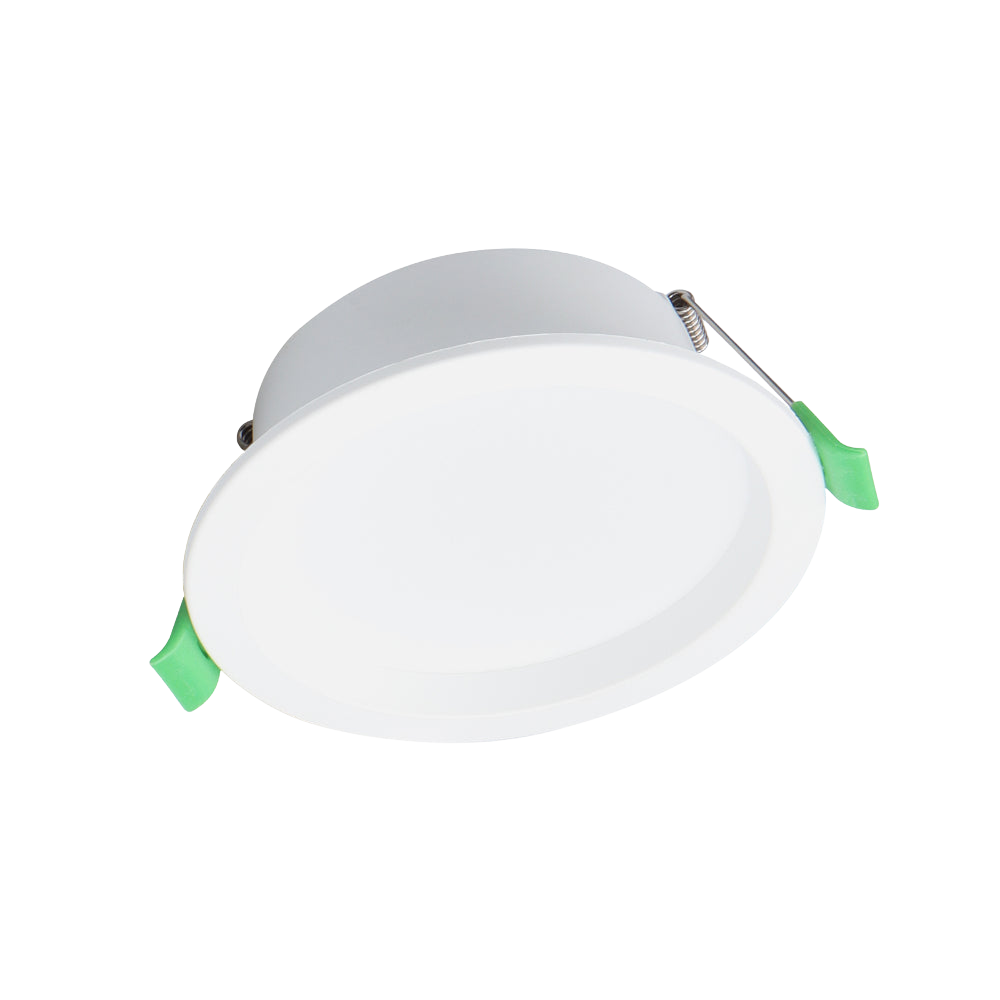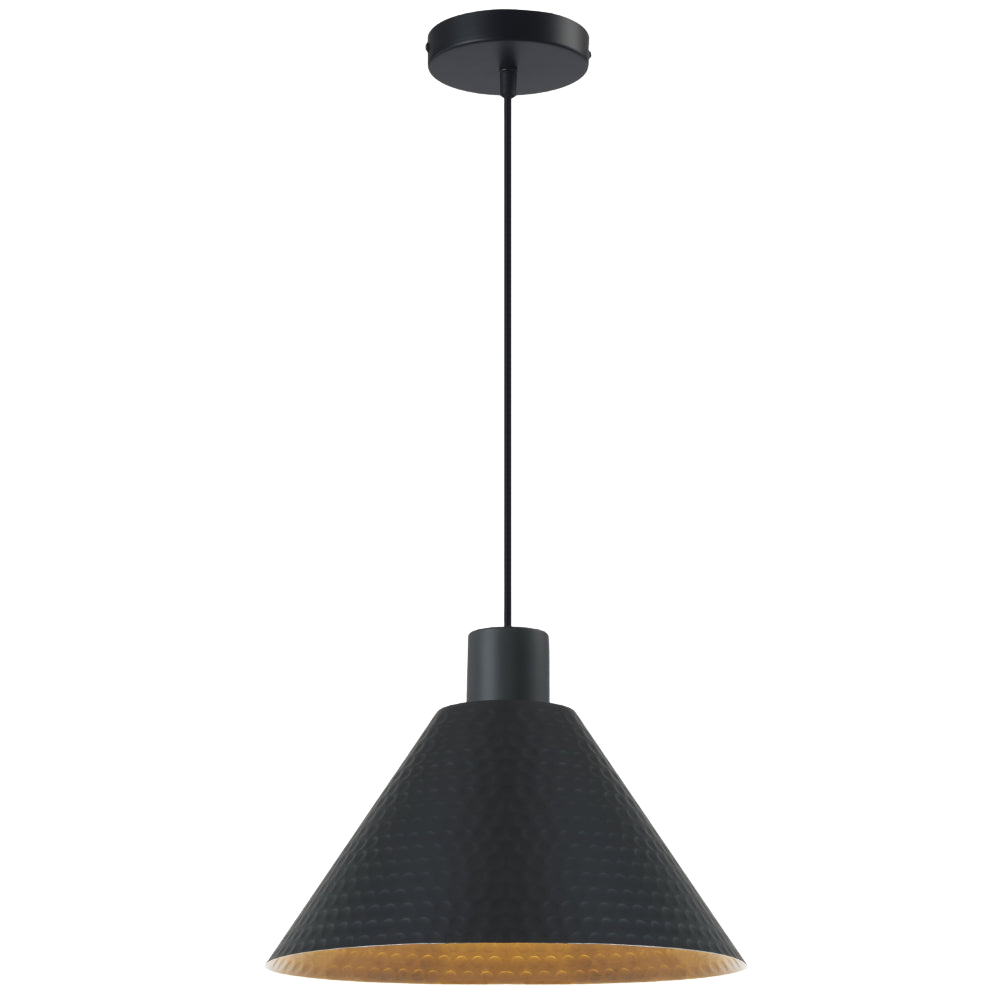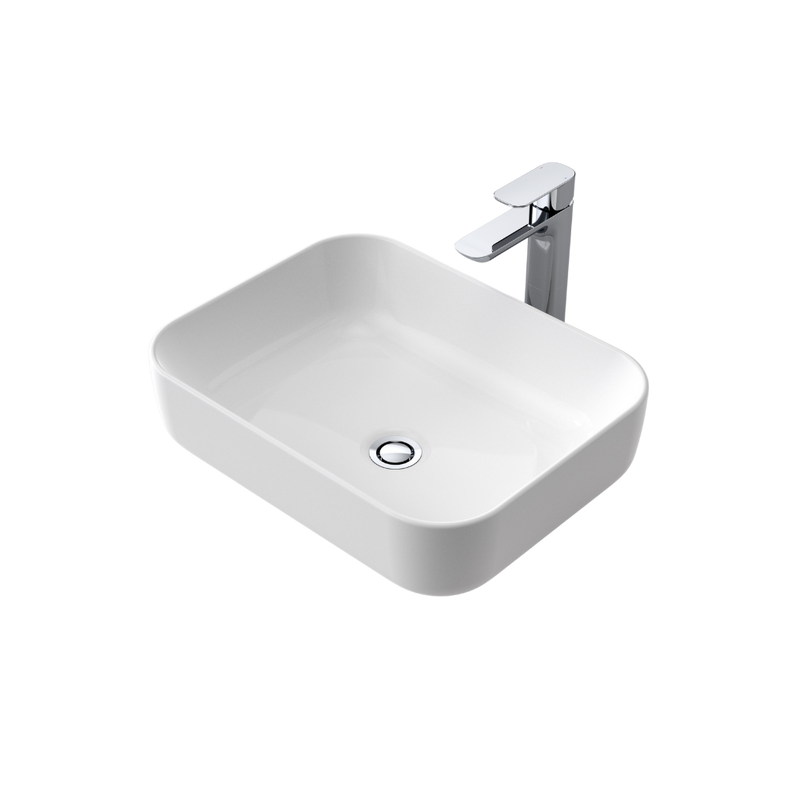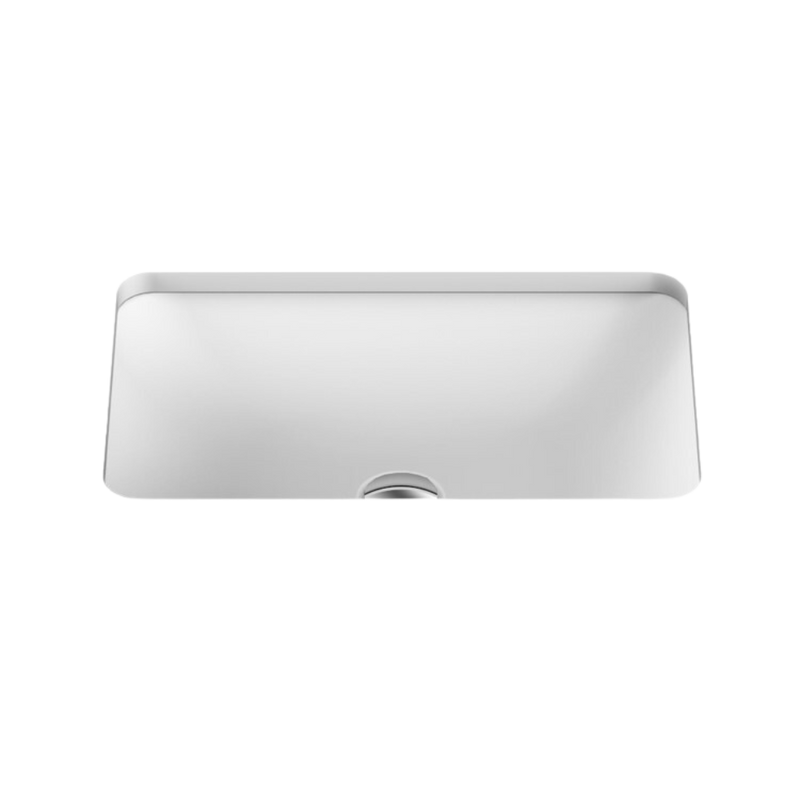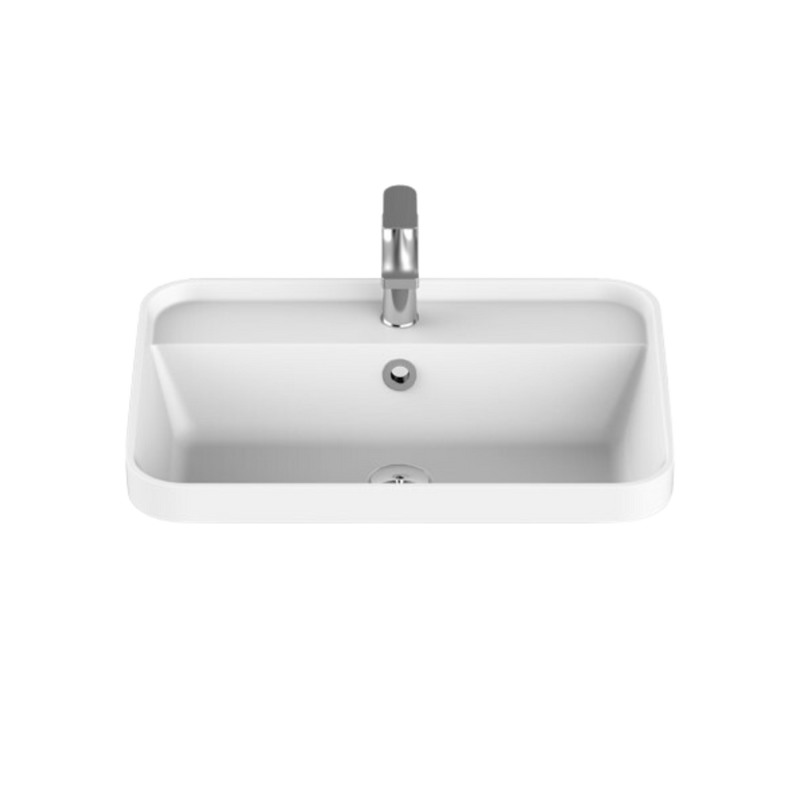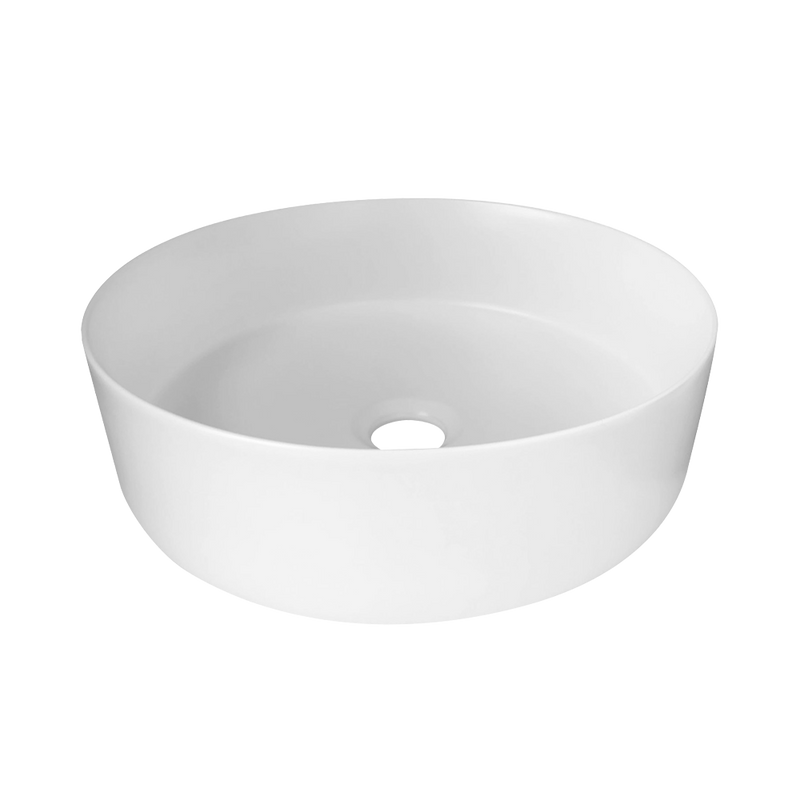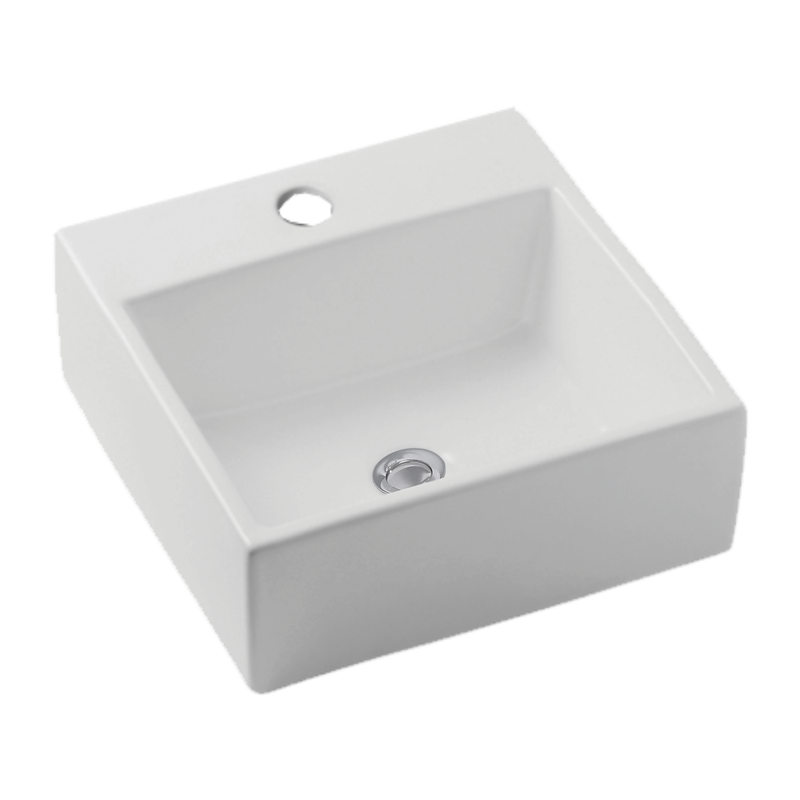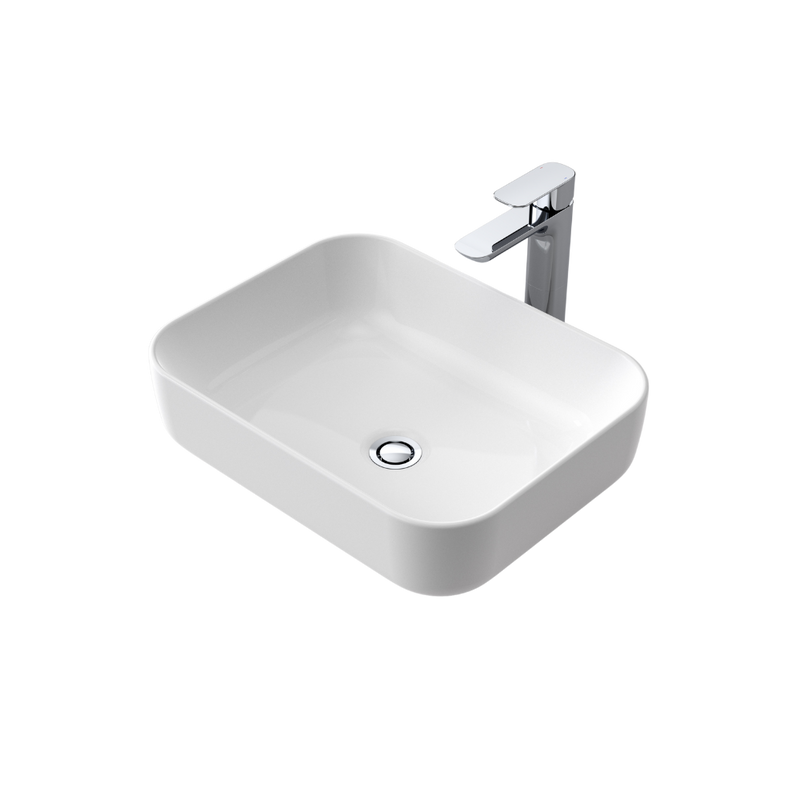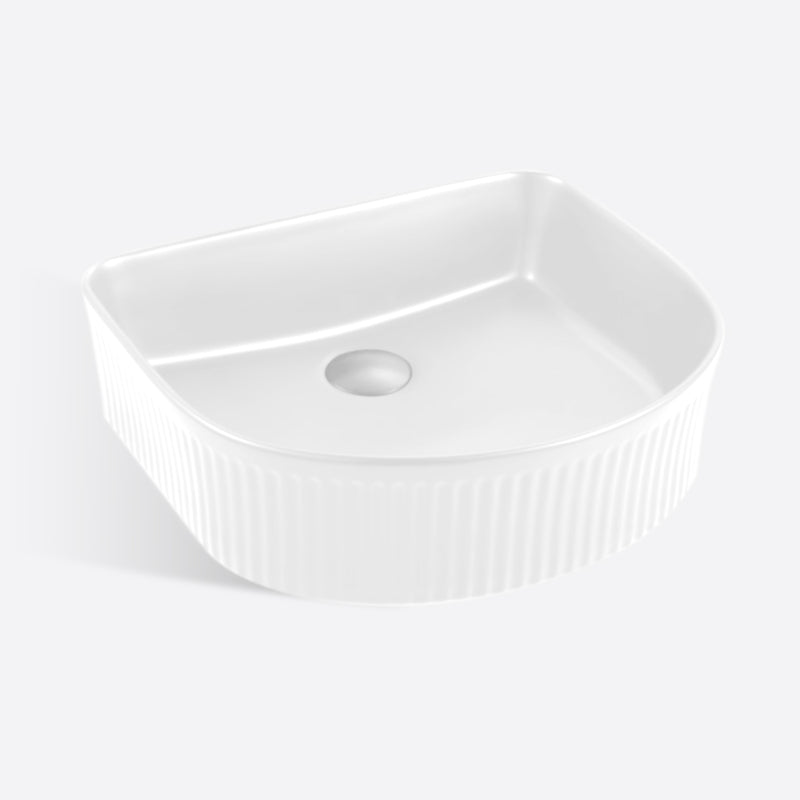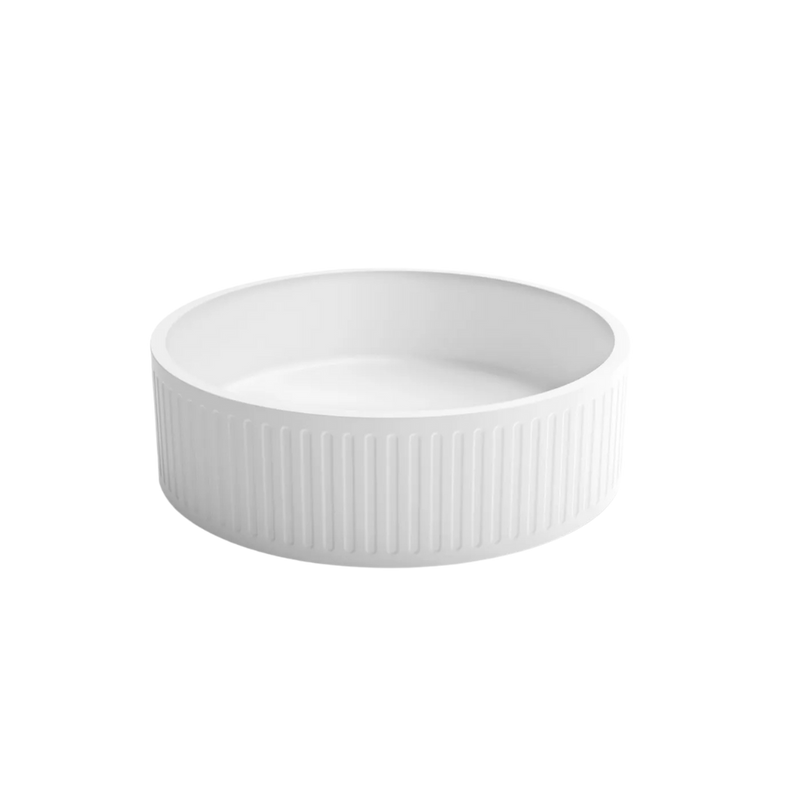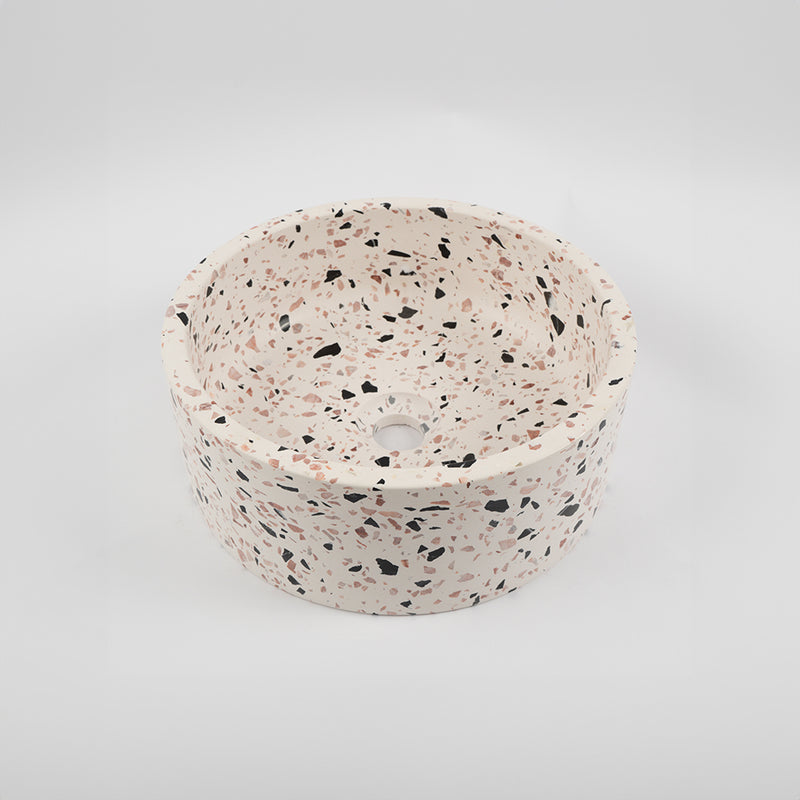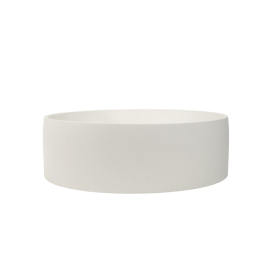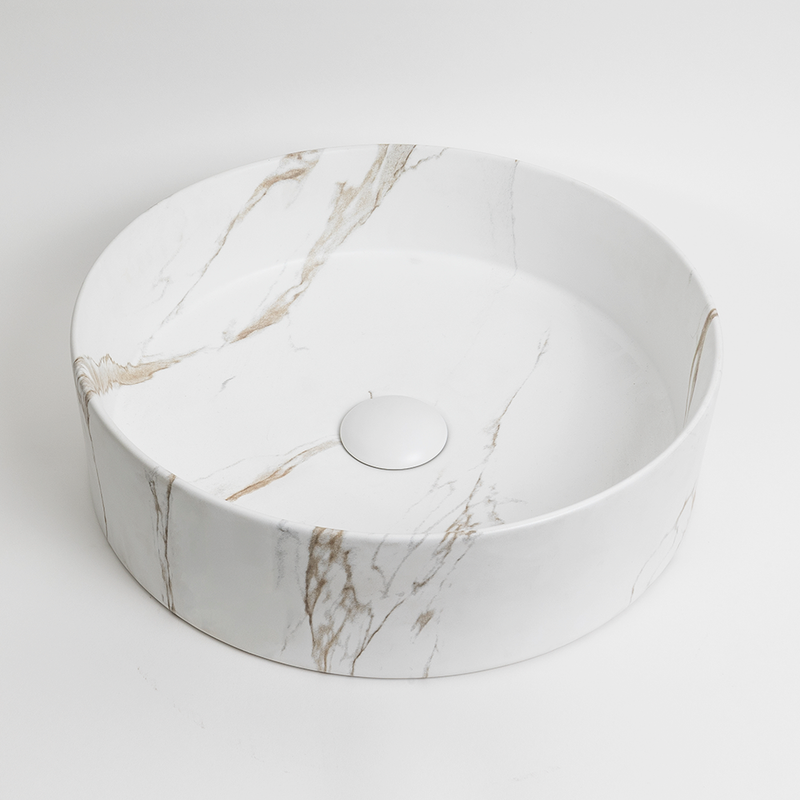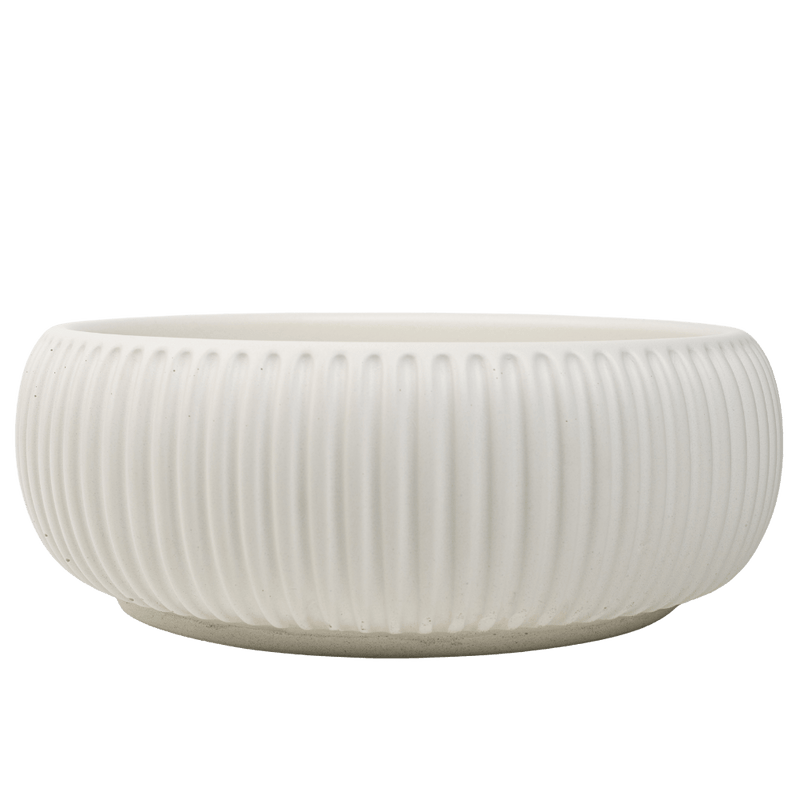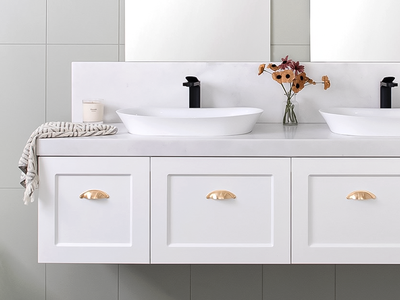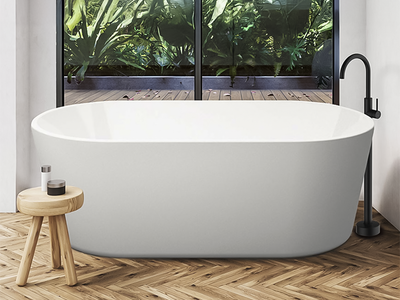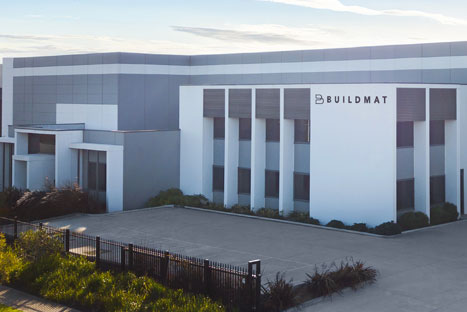The Renovator’s Guide to the Best Bathroom Basins (2025)
A well-chosen bathroom basin anchors both the function and finish of your bathroom.

This guide cuts through the noise with expert-backed tips, side-by-side comparisons, and real-world advice to help you choose a basin that fits your layout, elevates your style, and works for how you actually use the space.
Discover how installation, style and shape influence the seamless integration of your bathroom basin into your bathroom’s layout.
How Much Should You Budget for a Bathroom Basin?
Set aside around 5-10% of your total bathroom renovation budget for the basin, including fixtures, tapware, and installation.
This gives you enough room to choose a basin that’s both practical for everyday use and visually aligned with your design goals.
Wall-hung and above-counter basins create a designer look and offer more benchtop flexibility but may require custom cabinetry or altered plumbing positions. Undermount and semi-inset basins are more cost-effective and easier to clean around, great for busy family bathrooms or shared en-suites.
💎 Buildmat Pro Basin Budgeting Tip
Your basin position shapes cabinet layout, tap placement, and plumbing access. Decide early so cabinetry, waste outlet location, and wall heights can be planned around it, especially if you’re opting for twin sinks or a feature basin style.
How Basin Installation Style Affects Your Bathroom’s Space and Layout
The installation style of your basin shapes how much bench space you have, how easy it is to clean, and what’s possible with your plumbing.
Above-counter and wall-hung basins offer a striking, modern look, while undermount or inset basins are seamless and space-efficient, especially useful in compact or high-use bathrooms.
Above-counter basins sit on top of the vanity, adding height and sculptural appeal, but require compatible tapware and more cleaning around the base. Wall-hung basins free up floor space and suit minimalist ensuites or powder rooms, but may limit storage below. Inset and undermount basins create a flush, low-maintenance surface that’s ideal for shared or family bathrooms.
💎Buildmat Pro Installation Tip
Working with tight dimensions? Inset or undermount basins maximise usable bench space.
Want to make a visual statement? Choose a vessel-style basin or offset twin basins for added symmetry. Ensure you check your plumbing rough-ins early, as not all styles are suitable for every setup.
Above Counter Basins
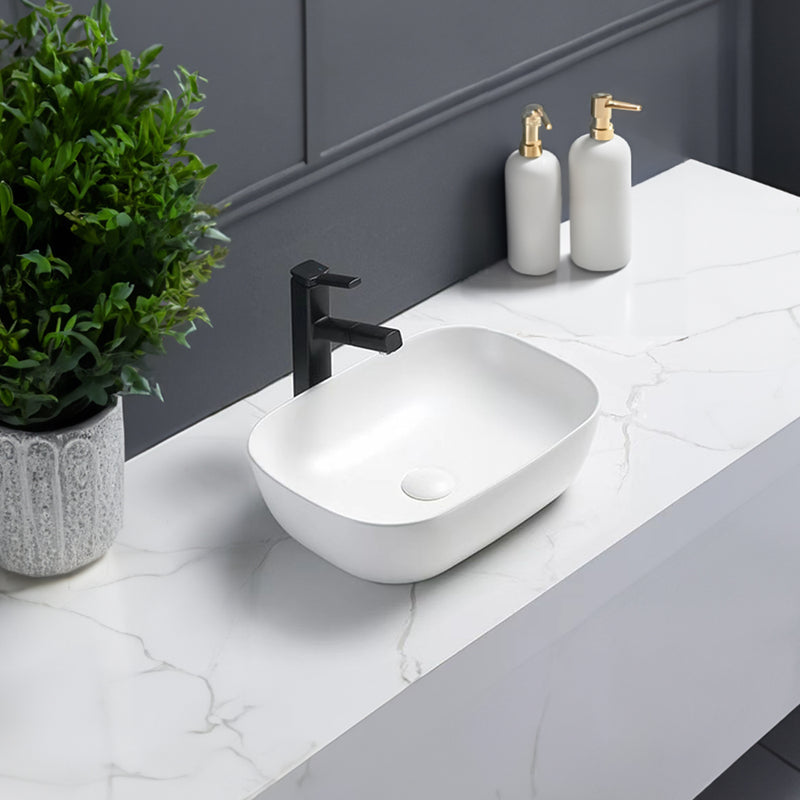
WHY ABOVE COUNTER BASINS MAKE A STATEMENT WITH MINIMAL DISRUPTION
Above counter basins are ideal for design-led renovations where you want your basin to be a visual feature. They sit fully above the benchtop, creating a sculptural, elevated look while keeping installation straightforward. This makes them a popular choice for vanities with plenty of bench space or powder rooms.
Their raised profile gives you more storage inside the vanity and allows for flexible pairing with tall or wall-mounted tapware. You’ll also find more variety in shapes, colours, and materials since the basin isn’t confined to a cut-out.
WHAT TO CONSIDER BEFORE CHOOSING AN ABOVE COUNTER BASIN
Above counter basins require careful height planning: both the vanity and tapware need to work together to maintain comfortable use. Too high, and daily tasks like face washing become awkward.
They’re also more prone to splash, especially in shallower models, and the exposed outer surface means more frequent wiping. Seal your benchtop properly, as water can pool around the base.
Undermount Basins
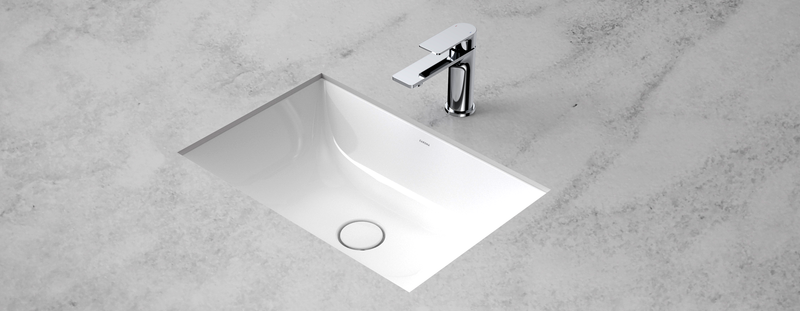
WHY UNDERMOUNT BASINS OFFER A SLEEK LOOK AND EASY CLEANING
Undermount basins are best for minimalist or high-use bathrooms where you want a clean benchtop finish with no rim to catch grime. Installed beneath the counter, they allow for seamless wipe-downs and uninterrupted surface flow.
They’re a smart option for family bathrooms or modern ensuites where function and form need to align.
WHAT TO CONSIDER BEFORE CHOOSING AN UNDERMOUNT BASIN
Undermounts require a solid surface benchtop like stone or engineered material to support the basin from underneath. They’re not compatible with laminate or timber tops.
Installation is more complex and may need extra sealing or bracketing for long-term stability. You’ll also lose a small amount of internal storage space due to the under-hung profile.
Semi-Recessed Basins
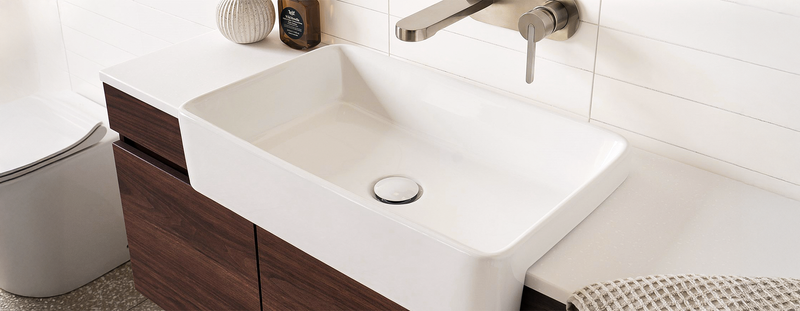
WHY SEMI-RECESSED BASINS SAVE SPACE WITHOUT SACRIFICING BENCH ACCESS
Semi-recessed basins are perfect for tight bathrooms or narrow vanities where you need full basin depth without full benchtop depth. They sit partially into the vanity, with the bowl projecting outwards, giving you usable benchtop and cabinet space behind.
They work well in small family bathrooms or powder rooms where space and access are both priorities.
WHAT TO CONSIDER BEFORE CHOOSING A SEMI-RECESSED BASIN
Because the basin protrudes, it becomes more prominent in the space, great for accessibility, but not ideal if you’re chasing a clean-lined look.
You’ll also need a vanity designed to accommodate the partial inset, and it may limit internal drawer space. Always check that your tapware and plumbing can align with the shallower bench.
Semi-Inset Basins
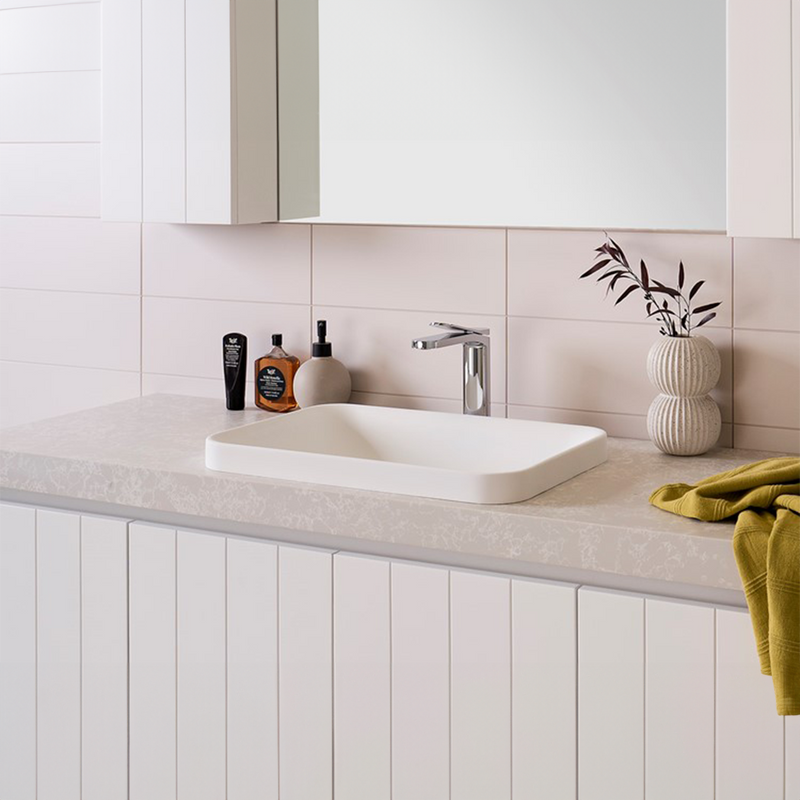
WHY SEMI-INSET BASINS BALANCE FORM AND FUNCTION IN TIGHT LAYOUTS
Semi-inset basins are a smart middle ground when you want a statement edge but don’t have space for a full above-counter design. They sit partly above and partly within the vanity top, allowing for bolder designs while keeping a lower overall height.
Ideal for family bathrooms and compact ensuites, they suit both design-led and functional briefs.
WHAT TO CONSIDER BEFORE CHOOSING A SEMI-INSET BASIN
The partial above-bench profile can impact tapware height and placement, so choose mixers that work with the exposed lip.
This installation style requires a custom cut-out in your vanity benchtop, which may add cost and reduce flexibility if you plan to swap it later. Cleaning is easier than a full above counter, but the join still needs regular attention.
Wall-Hung Basins
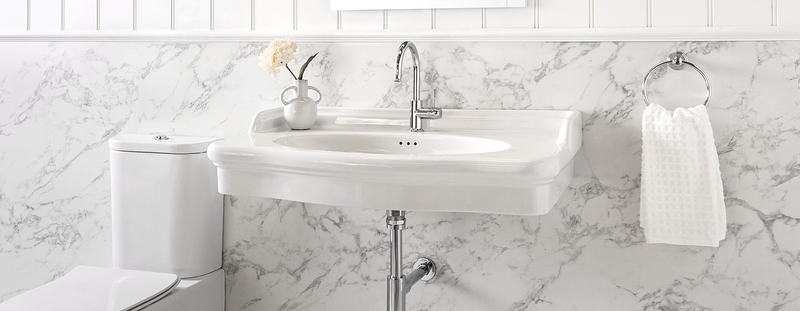
WHY WALL-HUNG BASINS MAXIMISE FLOOR SPACE AND VISUAL LIGHTNESS
Wall-hung basins are ideal for compact bathrooms where you want to free up floor area and make the room feel more open. Fixed directly to the wall with no vanity below, they’re a go-to for minimalists, renters, and accessible designs. They create a clean, contemporary aesthetic and are easy to clean beneath, especially useful in powder rooms or narrow ensuites.
WHAT TO CONSIDER BEFORE CHOOSING A WALL-HUNG BASIN
Choosing a wall-hung basin requires solid wall support and precise plumbing locations, which can increase installation complexity. With no cabinetry beneath, you sacrifice storage, so consider pairing with wall shelving or mirror cabinets. Tapware may need to be wall-mounted, and exposed bottle traps should be factored into your finish selection.
How to Choose the Best Basin Shape for Your Bathroom
The shape of your basin influences how it fits your vanity, functions day to day, and how it feels to use.
Getting the shape right can improve flow, reduce splashing, and align your basin with the rest of your bathroom layout. Curved and round basins soften tight spaces and suit organic or family-friendly designs. Rectangular and square basins maximise surface area and lend themselves to modern or architectural schemes.
Once you’ve locked in your vanity size and tapware type, shape is what ties everything together: visually and practically.
Round Basins
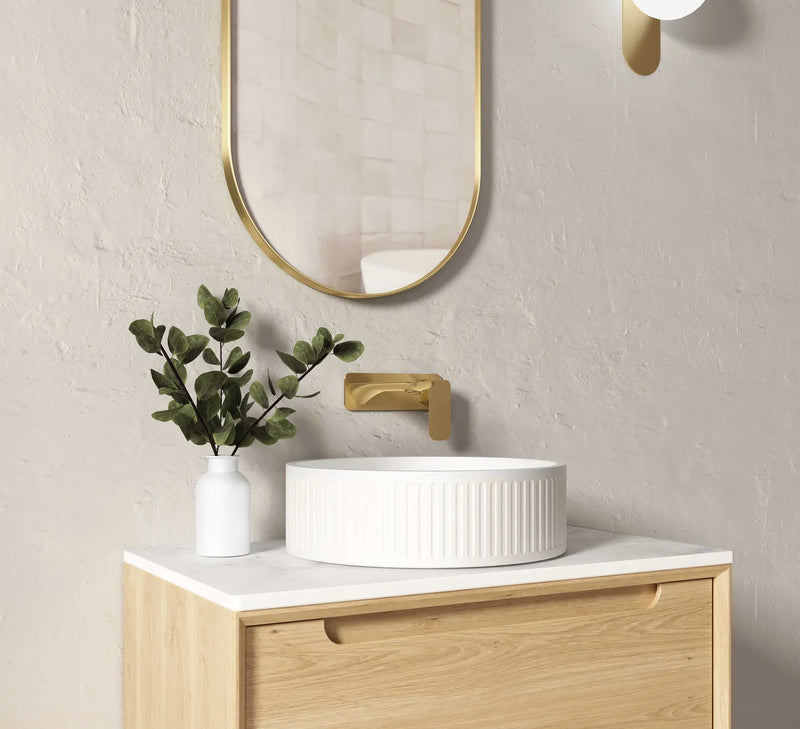
WHY ROUND BASINS SOFTEN SHARP BATHROOMS AND SIMPLIFY CLEANING
Round basins create a smooth, symmetrical focal point that suits minimalist or traditional bathrooms. With no sharp corners, they’re easier to clean and soften the visual impact of tight or angular spaces. The curved silhouette feels organic and gentle, often making smaller vanities look more open. They’re a natural match for curved tapware, arched mirrors, or timber accents.
WHAT TO CONSIDER BEFORE CHOOSING A ROUND BASIN
Round basins can limit usable surface space on the bench compared to rectangular styles. They may not suit bathrooms with strong linear or architectural themes. If storage or edge-to-edge functionality is a priority, a more angular shape might work better.
Pill & Oval Basins
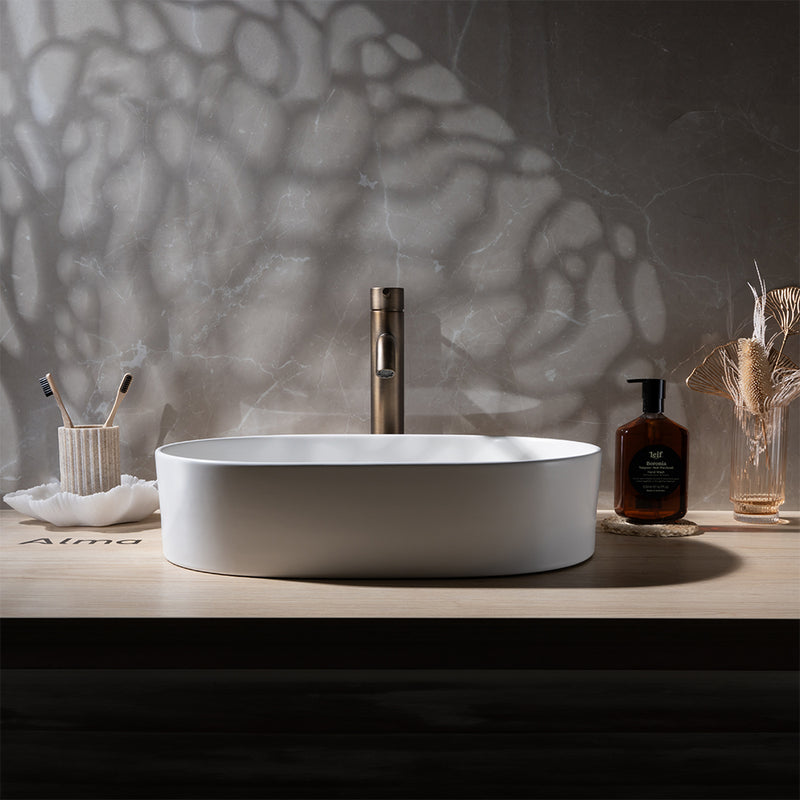
WHY PILL BASINS BLEND SOFTNESS WITH MODERN SYMMETRY
Pill-shaped basins combine the gentle edges of a round basin with the linear length of a rectangle, creating balance across narrow or wide vanities. Their soft-oval form feels modern yet understated, ideal for ensuites or shared bathrooms chasing a refined, spa-like feel.
WHAT TO CONSIDER BEFORE CHOOSING A PILL BASIN
Pill basins tend to run longer than round styles, so make sure your vanity can accommodate the full footprint. Consider where your tapware will sit: wall-mounted or offset mixers often work better with this shape than centre-set tapware.
Square Basins
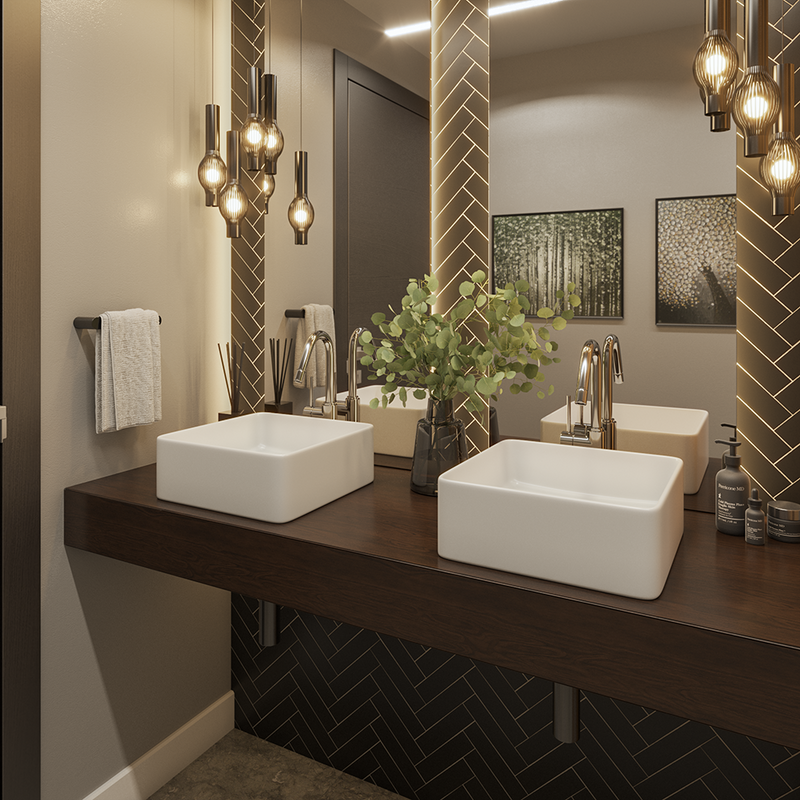
WHY SQUARE BASINS BRING A STRONG, ARCHITECTURAL PRESENCE
Square basins offer a bold, modern statement that complements geometric or industrial interiors. Their sharp lines add a sense of structure and contrast, especially in clean, monochrome bathrooms. They work particularly well with boxy vanities and straight-edged mirrors for a cohesive, angular look.
WHAT TO CONSIDER BEFORE CHOOSING A SQUARE BASIN
Corners can collect grime, so regular cleaning can help maintain sharp visuals. Square basins can also feel more dominant in small spaces, so ensure your layout can handle the visual weight.
Rectangular Basins
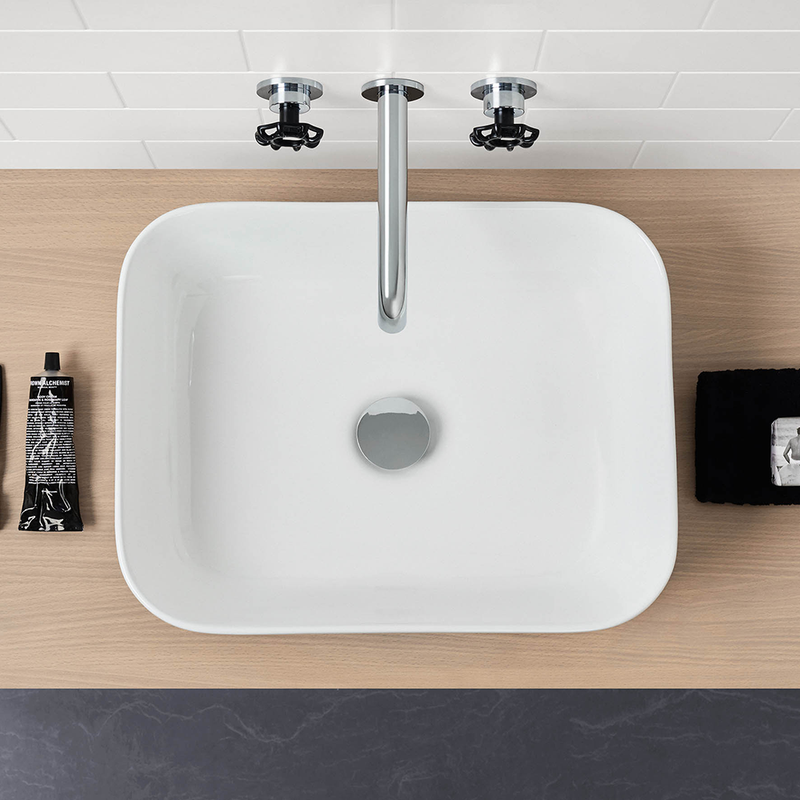
WHY RECTANGULAR BASINS MAXIMISE BENCH SPACE AND FUNCTION
Rectangular basins are one of the most versatile formats, offering ample internal volume and more usable surface area along the vanity. They suit most bathroom styles, from classic to ultra-modern, and provide a practical solution for busy households that need efficient, multi-user setups.
WHAT TO CONSIDER BEFORE CHOOSING A RECTANGULAR BASIN
Rectangular basins are usually wider and deeper, so they need a longer vanity or benchtop for proper proportion. Ensure your plumbing and tapware align well with the width, and consider splash potential if the bowl is shallow.
Arch Basins
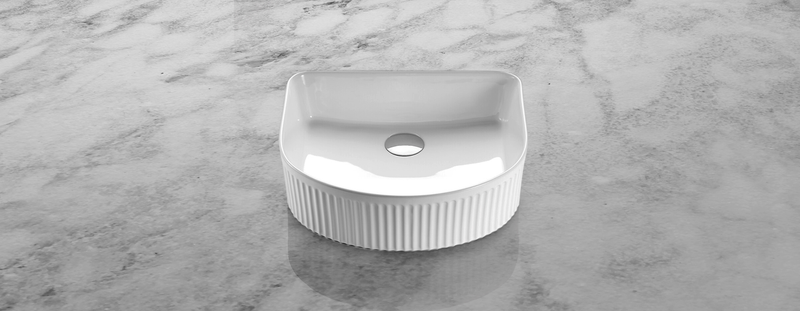
WHY ARCH BASINS ADD PERSONALITY AND A TOUCH OF PLAYFULNESS
Arch basins turn a functional fixture into a design feature, adding a soft, architectural curve that breaks up rigid lines in a bathroom. They pair well with arched mirrors, curved vanities, or Mediterranean-inspired spaces, and often become the hero of a smaller powder room or ensuite.
WHAT TO CONSIDER BEFORE CHOOSING AN ARCH BASIN
Given their stylised shape, arch basins may limit tapware placement or bench compatibility. Consider how the visual curve aligns with your overall theme, and check for splash zones if the bowl sits high or shallow.
How to Choose the Right Basin Style
The best basin style adds personality to your space while supporting your practical needs.
Whether you're after a sculptural focal point or a subtle layer of texture, the right finish can elevate even the most minimal bathroom design.
Consider how much of a statement you want to make, how often the basin will be used, and whether your space leans bold, neutral, or natural in tone. Each style has a distinct personality, and the right one can set the tone for your entire bathroom.
Fluted Basins
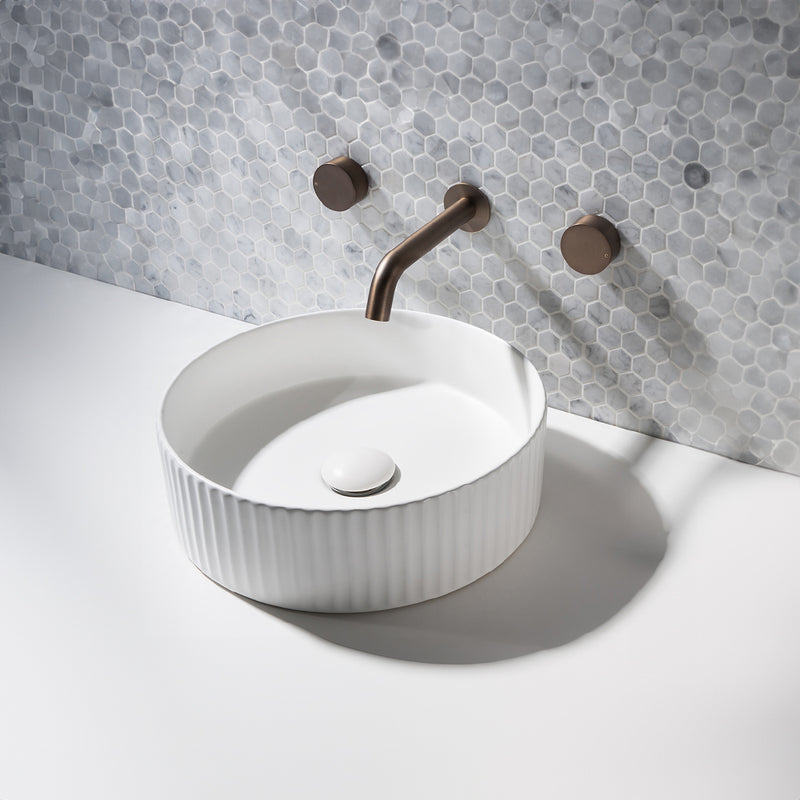
WHY FLUTED BASINS CREATE A SCULPTURAL FOCAL POINT IN ANY BATHROOM
Fluted basins add depth, texture, and elegance through their vertically grooved surface, making them a standout design feature in any space. The ribbed detailing plays with light and shadow, creating visual interest even in monochrome colour palettes.
This style works well as a centrepiece in powder rooms, ensuites or high-design spaces, instantly elevating the feel of the room. It balances classic detailing with contemporary form, offering a tactile edge that pairs beautifully with curved tapware or stone benchtops.
WHAT TO CONSIDER BEFORE CHOOSING A FLUTED BASIN
Fluted basins require more detailed cleaning than smooth surfaces, as dust or soap scum can settle into grooves.
Some models are more delicate due to the sculpted finish, so they’re better suited to low-traffic or adult-only bathrooms. If you’re after a bold look but prefer easier upkeep, consider fluted fronts paired with smooth internal bowls.
Terrazzo Basins
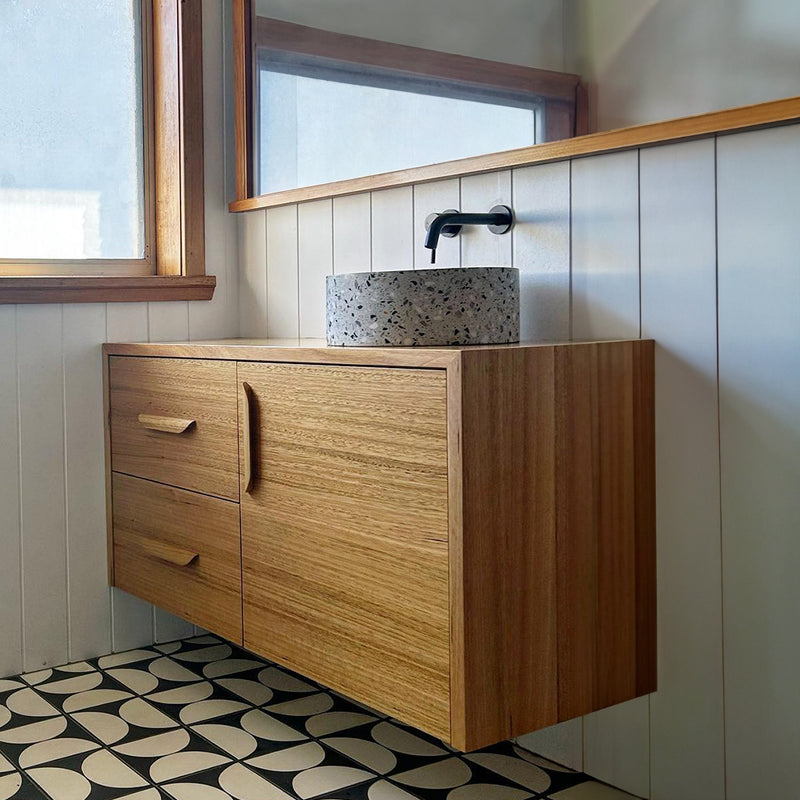
WHY TERRAZZO BASINS BRING COLOUR AND PERSONALITY TO CONTEMPORARY BATHROOMS
Terrazzo basins are playful, expressive, and full of character, ideal for making a statement without relying on bold paint or tile choices. Their speckled finish combines chips of stone, glass or resin for a layered, multicoloured effect.
They inject visual texture and work well as an accent in otherwise neutral or pared-back bathrooms. Terrazzo also feels naturally at home in mid-century, coastal, and eclectic interiors.
WHAT TO CONSIDER BEFORE CHOOSING A TERRAZZO BASIN
Due to their composite makeup, terrazzo basins can vary in surface feel and porosity. Choose a sealed version to resist stains and make cleaning easier. Keep in mind that coloured basins may limit your styling palette or clash with overly patterned tiles, best paired with simpler surfaces for balance.
Concrete Basins

WHY CONCRETE BASINS OFFER A RAW, MINIMALIST AESTHETIC WITH DESIGN WEIGHT
Concrete basins deliver a strong architectural presence and a matte, tactile surface that complements modern, industrial and minimalist bathrooms. Their weight and handmade finish give them a sculptural feel, often with subtle variations that add to their charm.
They work best as a contrast to softer materials like timber or brushed metal, and their durability suits both residential and commercial spaces seeking impact.
WHAT TO CONSIDER BEFORE CHOOSING A CONCRETE BASIN
Concrete is porous and can develop a patina over time if left unsealed. It requires regular sealing and gentle cleaning to prevent stains and etching.
Some models are heavy, so check that your vanity or wall mount is rated for its weight. The industrial look isn’t for everyone. It’s bold, raw and intentionally imperfect.
Marble Look Basins
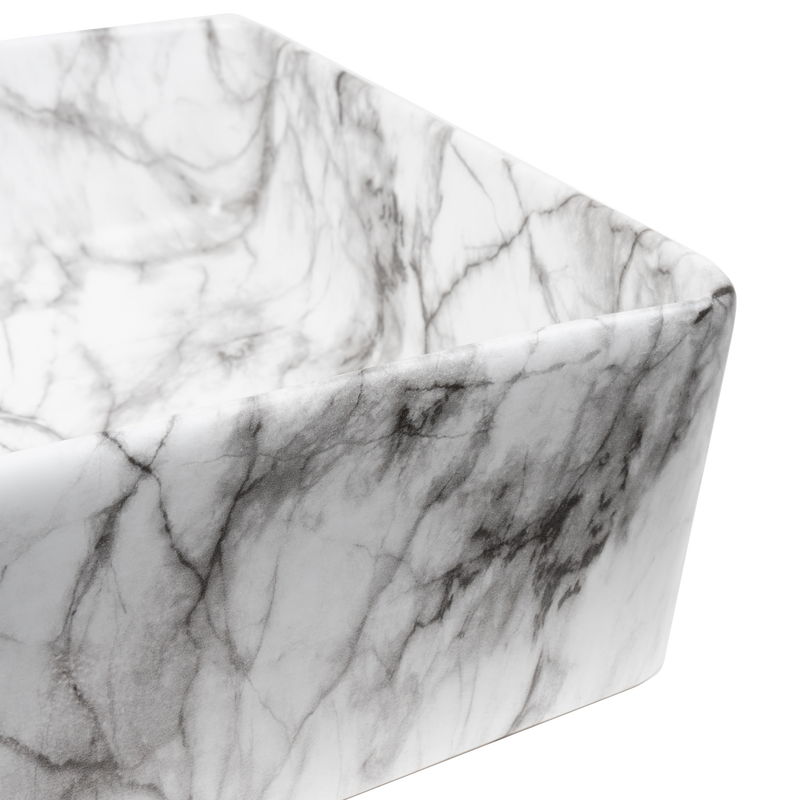
WHY MARBLE LOOK BASINS BRING INSTANT SOPHISTICATION WITHOUT THE UPKEEP
Marble look basins mimic the beauty of natural stone with less cost, weight, and maintenance. Their veined finish creates timeless appeal, working well in luxury, Hamptons, or classic-inspired bathrooms.
They offer the high-end aesthetic of real marble while being lighter and less porous, making them easier to clean and install.
WHAT TO CONSIDER BEFORE CHOOSING A MARBLE LOOK BASIN
These are typically made from composite materials or are ceramic basins with a printed or cast marble effect. While they’re durable, the patterning may vary across batches. Always view your specific piece before installation.
If you're seeking the look of real stone with improved practicality, marble-look offers the perfect balance.
Stone Look Basins
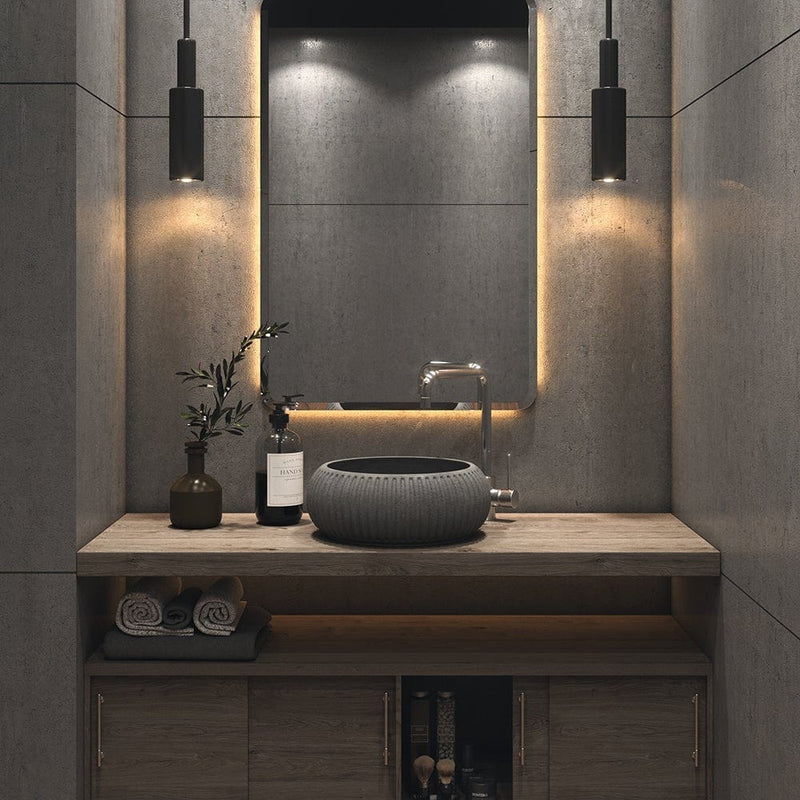
WHY STONE LOOK BASINS ADD A NATURAL, TEXTURED FEEL TO CALMING SPACES
Stone look basins offer an organic aesthetic with the strength and low-maintenance benefits of engineered materials. Their matte or satin finish softens harsh lighting and brings a grounded, earthy element to your space. Ideal for neutral, spa-inspired, or coastal bathrooms, they pair beautifully with brushed tapware and timber finishes.
WHAT TO CONSIDER BEFORE CHOOSING A STONE LOOK BASIN
Stone look finishes vary in colour and texture: from smooth river stone effects to grainy sandstone-style surfaces. Some models can show water spots or soap scum more visibly, so opt for a lightly textured or satin finish to reduce upkeep. While they suit many palettes, they’re best paired with other natural tones and soft finishes for cohesion.
Must-Have Accessories to Complement Your Basin
The right accessories can take your basin from functional to flawless. They improve usability, protect finishes, and tie your bathroom design together.
Start with matching tapware and basin waste to keep your finish consistent across fixtures. Add a bottle trap cover for a polished look, especially with wall-hung basins. Drawer organisers, mirror shelves or soap trays help keep clutter at bay and surfaces clean. For added convenience, consider pairing your basin with a shaving cabinet or mirrored wall unit for extra storage in tight spaces.
Buildmat’s curated basin accessories are designed to work seamlessly with a wide range of shapes, finishes, and installation styles, so your setup looks good and performs even better.
Browse Buildmat’s Curated Basin Accessory Range
How to Clean and Maintain Your Basin
Regular cleaning keeps your basin looking polished and performing well, while preventing stains, residue build-up, and long-term wear, especially around high-touch areas like the bathroom tapware and waste.
Daily Cleaning
Wipe the basin bowl, edges, and tapware with a soft cloth and a pH-neutral cleaner after use. This helps prevent water marks, toothpaste residue, and grime. For matte, fluted, or textured finishes, use a damp microfiber cloth and avoid heavy scrubbing. Glossy finishes may require buffing with a dry cloth to stay streak-free.
Deep Cleaning
Once a week, clean the full surface, including under the lip, around the tap base, and near the overflow. Use a soft brush or non-abrasive sponge to get into seams and detail work. For undercounter or semi-inset basins, pay attention to the join between the benchtop and bowl. If your basin is coloured or stone-look, use products recommended for that specific material.
Avoid Harsh Chemicals
Bleach, acidic cleaners, and abrasive powders can dull finishes or damage protective coatings. Avoid steel wool or scouring pads and stick with gentle, non-acidic cleaners and always patch-test unfamiliar products.
Routine Checks
Inspect around the waste, tapware, and overflow monthly for signs of mould, mildew, or slow leaks. For wall-hung basins, ensure fixings remain tight and sealed. Reapply silicone if you see cracking or separation where the basin meets the wall or vanity.
Protection Accessories
Add basin trays to catch spills, and use felt bumpers in drawers below to protect against water damage. For open basin styles, consider bottle trap covers or decorative pipework to keep plumbing tidy and coordinated. Drawer organisers and soap dishes also help keep the area clutter-free and cleaner over time.
Complete your bathroom’s look with the perfect basin.
Choosing the right basin means getting the shape, size, and installation style that fits your layout, complements your tapware, and supports everyday use. Whether you’re designing for a compact ensuite or a bold, design-led space, the right basin ties form and function together.Still comparing options? Browse Buildmat’s full basin collection to explore styles, finishes, and formats, or chat with our team for expert, layout-specific advice.Explore Buildmat's full basin range →Need help choosing? Chat with our team →
Frequently Asked Questions
FAQs
Start by matching your tap height to the basin style. Above-counter basins need taller mixers or wall-mounted taps to avoid splashing, while semi-recessed or undermount basins work well with standard-height mixers.
Yes, but check cut-out compatibility and plumbing alignment. Undermount and semi-inset basins often require custom cabinetry or bench cuts. Measure carefully before swapping styles.
While often used interchangeably, “basin” typically refers to bathroom use, designed for handwashing and grooming, while “sink” is more common in kitchens or laundries, built for heavier-duty tasks.
Not necessarily. Matte white basins or darker finishes can show soap marks or mineral streaks more easily, but regular wipe-downs with a microfibre cloth keep them looking clean. Avoid harsh cleaners that might dull the surface.
Yes. Wall-hung basins must be mounted into wall studs or bracing to support their weight. Always check installation instructions and consult your builder if in doubt.























































































































































































































































